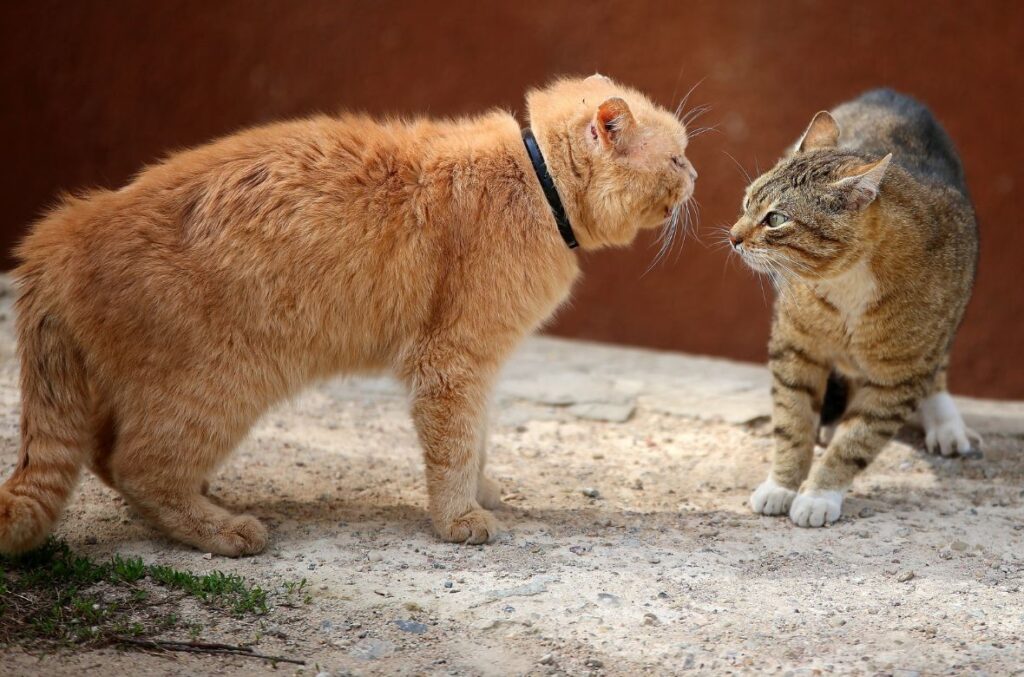How Do I Address Aggressive Behavior Between My Cats?
Aggressive behavior between cats can be distressing for both feline and human family members.
Understanding the causes and implementing proactive strategies is essential to foster a peaceful coexistence among your furry friends.

1- Decoding Feline Aggression
Understanding Cat Body Language: Signs of Aggression
Delve into the nuances of cat body language to identify signs of aggression. From hissing to flattened ears, recognizing these cues is crucial for addressing and preventing aggressive encounters.
Root Causes of Cat Aggression: Unraveling the Triggers
Explore common triggers for feline aggression, including territorial disputes, fear, redirected aggression, or underlying health issues. Identifying the root cause is essential for implementing targeted solutions.
2- Strategies for Addressing Aggressive Behavior
Gradual Introduction: Rebuilding Cat Relationships
If introducing a new cat, or addressing aggression between existing cats, take a gradual approach. Use scent swapping and controlled visual exposure to slowly acclimate cats to each other.
Resource Management: Eliminating Competition
Reduce potential triggers by providing multiple resources such as food bowls, litter boxes, and resting spots. Eliminate competition for these resources to mitigate aggressive behavior.
Play Therapy: Channeling Energy Positively
Engage in interactive play sessions to release excess energy and reduce tension. Toys that encourage chasing and pouncing can redirect aggressive tendencies into more positive outlets.
3- Behavior Modification Techniques
Positive Reinforcement: Rewarding Peaceful Interactions
Encourage positive interactions between cats through rewards. Treats, praise, or playtime can reinforce calm behavior and create positive associations between the cats.
Utilizing Safe Spaces: Creating Retreats
Designate safe spaces where each cat can retreat when feeling stressed or threatened. Providing vertical spaces, cozy hiding spots, or separate rooms can help alleviate tension.
Consulting a Professional: Seeking Veterinary Advice
If aggression persists, consult with a veterinarian or a professional animal behaviorist. They can assess the situation, rule out medical issues, and provide tailored behavior modification plans.
Conclusion
Addressing aggressive behavior between cats requires a combination of understanding feline communication, implementing proactive strategies, and, when needed, seeking professional advice.
With patience and dedication, you can create a harmonious environment where your cats can coexist peacefully.
FAQs
Why Are My Cats Suddenly Fighting?
Sudden fights can be triggered by changes in the environment, new additions to the household, or underlying health issues. Identify the cause to address the aggression effectively.
Is Hissing Always Aggressive?
While hissing is often a sign of aggression, it can also indicate fear or discomfort. Assess the overall body language and context to understand the cat’s emotional state.
Can Neutering/Spaying Reduce Aggressive Behavior? Neutering/spaying can reduce territorial aggression and certain mating-related behaviors. Consult with your veterinarian to determine the best course of action for your cats.
Should I Punish My Cats for Fighting?
Avoid punishment, as it can escalate aggression and create fear. Instead, focus on positive reinforcement and implementing behavior modification techniques to promote peaceful interactions.
Can Cats Learn to Get Along After Aggressive Episodes?
Yes, with patience and consistent intervention, cats can learn to coexist peacefully. Implement gradual introductions, positive reinforcement, and provide a conducive environment to foster harmony.
How Long Does It Take for Cats to Stop Fighting?
The duration varies based on the cats’ personalities, history, and the underlying causes of aggression. Consistency in implementing behavior modification strategies is key to achieving long-term success.
